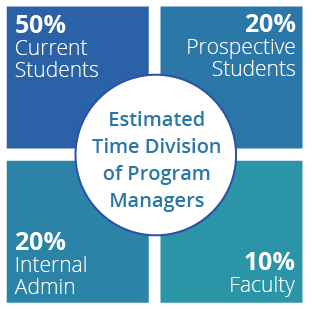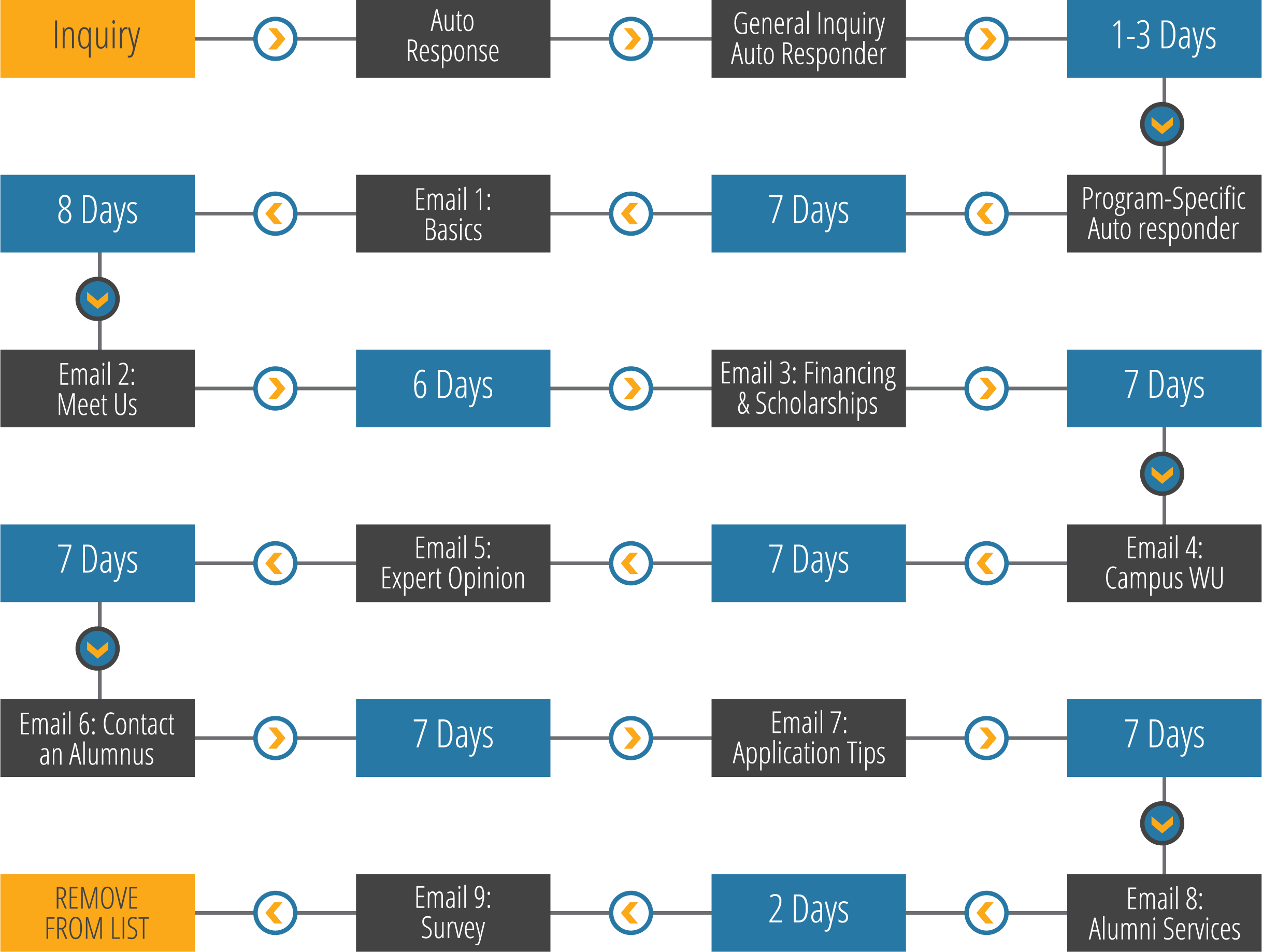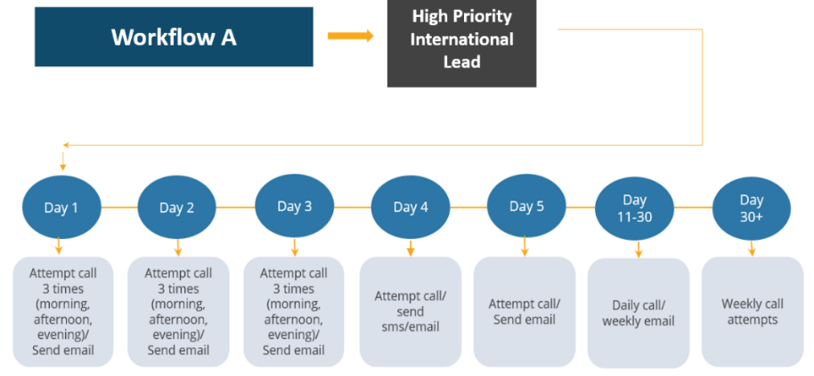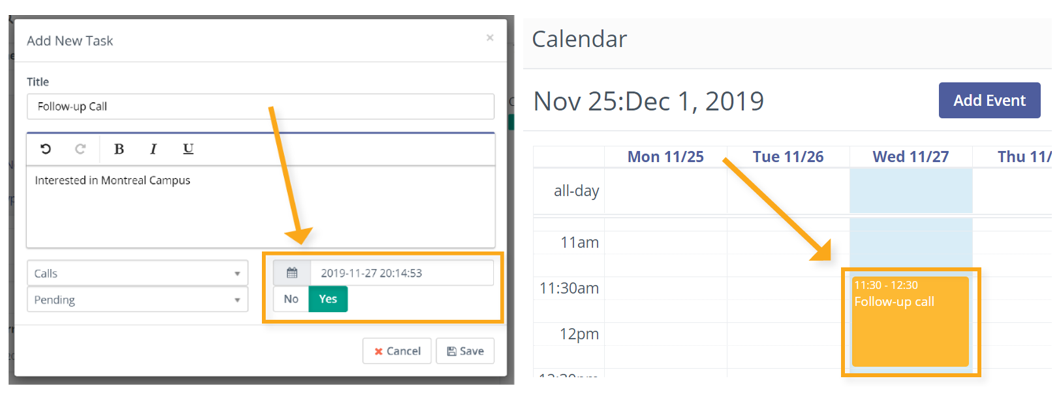
The life of admissions staff is a busy one, and there are endless tasks you are expected to keep up with simultaneously.
As a result, it can be easy to go on autopilot and focus on getting things done without thinking about how to increase efficiency, instate new ideas, or improve current practices.
That’s where a lead conversion audit comes in handy. This useful exercise involves closely inspecting each aspect of your admissions follow-up process – from call response time to email workflows – to identify areas where you can make it more efficient, personalized, and effective.
Does your school’s recruitment strategy need optimizing? Read on to learn about the many improvements a lead conversion audit can help you make.

1. Evaluate Your Admissions Funnel With a Lead Conversion Audit for Schools
The admissions funnel is the backbone of any school’s recruitment efforts, indicating how many leads you generate, how many go on to apply, and how many ultimately become students.
Understanding the health of your funnel is key to understanding how effective your school’s follow-up process is. Because of its importance, an in-depth analysis of your school’s admissions funnel is often the first phase of a lead conversion audit for schools.
Example: The chart below may seem simple enough, but the insight it provides is of utmost importance. If you discover that you’re generating lots of leads, but few go on to enroll, you may want to re-evaluate your follow-up process. Conversely, if you’re enrolling a large percentage of your total leads, you know you’re effectively moving prospects through the funnel – but you may want to focus on improving your online presence so that you generate more inquiries.

A lead conversion audit will also analyze the funnel through the lens of your admissions staff. Through this exercise, you will see how many leads are assigned to each staff member over a given time frame to assess how your workload is distributed among your team.
Example: This part of the lead conversion audit process allows you to compare the number of leads each staff member manages, their quality, and the rate at which they enroll. Depending on the school, this part of the higher education digital marketing audit process may also involve analyzing other parameters such as location, program type, language, and more.

In addition to productivity, the above chart also indicates which point in the funnel your staff members best excel at. Take Staff 1 for instance: although they are allocated a relatively small share of leads, they generate the most students, which means they have a highly successful follow-up strategy that may be worth sharing with the rest of your team.
Staff 2, on the other hand, is great at urging leads to start their application – but few become students. This final number would likely improve if Staff 2 was encouraged to devote extra energy to prospects at the end of the enrollment funnel.
Every employee has their strengths and weaknesses. A lead conversion audit can help identify what they are in order to better train and equip your staff to more effectively move prospects towards enrollment.
2. Assess Your Team’s Workload Through a Digital Marketing Audit for Schools
Once you fully understand where your school’s admissions funnel is at, it can be tempting to jump right into the process of improving it. However, before implementing new tactics or upgrading current ones, it’s important to assess your team’s capacity to carry out any additional admissions work.
That’s why an integral part of a lead conversion audit involves looking at the daily workload of your admissions staff. This crucial step allows schools to get a realistic picture of how much they can do with the time they have allocated to following up with leads.
Through employee interviews, an audit will uncover how much of your team’s weekly workload is dedicated to following up with your prospective students.
This can be particularly useful if you have staff dealing with admissions who also have responsibilities in other areas. For instance, the chart below shows the workload of program managers who need to deal with issues related to current students and faculty in addition to following up on inquiries:

A lead conversion audit may also probe into which admissions-related tasks are the most time-consuming in order to find ways to make them more efficient. It may also be helpful to look at how much time is allocated to each incoming lead, and calculate how much time is needed in order to follow up with all of your prospective students.
This process provides invaluable insight into the bandwidth of your admissions team. You may discover that, if you make some processes more efficient, you’ll be able to reach your recruitment targets. Alternatively, you may find that you need to change the amount of time you allocate to prospective students, or even hire a new staff member in order to reach your goals.
3. Boost your Admissions Strategy with Competitor Benchmarking
After analyzing your admissions funnel and looking at your staff’s workload, you will likely have a comprehensive understanding of your school’s recruitment strategy and the capacity of your team to improve it.
But before you go on to do just that, you may want to first look at what your competitors are doing to move leads through the funnel. This component of a digital marketing audit is called competitor benchmarking and involves comparing your competitor’s follow-up strategies to yours.
But how, exactly, do you assess your competitors’ follow-up processes? One effective way is to have a team member or someone you hire externally pose as a prospective student and inquire with various schools. You can then assess the quality and quantity of follow-up received, along with its timeliness.
Example: The first thing that prospects receive after engaging in a conversion activity is usually an autoresponder email. In some cases, prospects will be placed in a workflow that sends additional emails after that. The chart below shows a timeline of follow-up emails from various schools.

This type of study allows schools to discover ways they could improve their follow-up process to stand out amongst the competition. For instance, the above chart indicates that the school may benefit from adding a deadline reminder email prior to the open day. It also reassures the school that their emails are likely to land in a prospect’s primary inbox, as opposed to their promotions tab.
In addition, a lead conversion audit will also dive into the very content of those emails. By analyzing the design, copy, and CTAs used in your competitors’ mails, your school will learn how to improve those elements in its own campaigns.
Example: Compare these two mock-up emails: which do you think would be more appealing to prospective students, and why? Experts conducting a lead conversion audit might point out that the email from ABC school is generic, not personalized, and doesn’t use any CTAs or provide any additional resources. The one from DEF school, in contrast, addresses the prospect by name and provides relevant information based on the prospect’s program of choice. There is also a CTA that urges prospects to take the next step in the admissions process.

Higher education is an undoubtedly competitive field, and it’s important to be aware of what your competitors are doing that you aren’t. Additionally, it can be extremely beneficial to know where your school excels in the lead conversion process, so you know where your resources are best allocated to convert more students.
4. Optimize Your Automated Lead Nurturing Processes
Successful automated lead nurturing requires two key components: segmentation and workflows. The former ensures that the latter is as personalized as possible.
Segmentation involves dividing your leads by various parameters such as demographics, program of interest, work experience, and more. You can also segment prospects by lead stage.
Schools can then use these segments to build personalized workflows. Through email, SMS, and other forms of communication, these automated workflows send prospects a series of messages tailored to their key characteristics.
The better suited your segments are to your prospective students, the more effective your automated workflows will be. And the more effective your automated workflows are, the more leads you’ll move towards enrollment without your admissions staff having to lift a finger.
Evaluating Prospective Student Segments
In a digital marketing audit, specialists will examine the segments you have in place and assess their relevancy. This way, schools will learn if they need more, less, or different segments – or if they should adopt a different approach to segmentation entirely.
Many experts say that the more segmentation, the better, and marketers who use segmented campaigns can see as much as a 760% increase in revenue. It’s safe to say that segmentation has an overwhelmingly positive impact on online communication – but does that mean schools should go about creating as many segments as possible?
The answer is likely no. Remember that the point of segmentation is to personalize communication, and there’s no point taking the time to create endless segmented workflows if they won’t have a tangible impact on your admissions funnel. After all, discovering the most efficient ways to enroll the most students is one of the most important goals of admissions consulting for schools.
Since each school has different priorities and audiences, the perfect segments will differ.
If your school offers a wide variety of courses, as is the case with universities, then perhaps segmenting by program type would be far too cumbersome for what it’s worth. On the flipside, if your prospects aren’t necessarily proficient in English, it may be advantageous to segment leads by language and create multilingual workflows.
Example: Here are some sample segments your school may find useful, as shown in HEM’s customized Mautic CRM. It’s important to segment contacts by a wide variety of parameters such as demographics, actions, and characteristics, and a digital marketing audit will help you determine which are right for your school.

Assessing Higher Ed Workflows
In the average lead conversion audit, a considerable amount of time is spent evaluating a school’s workflows.
It can be difficult to strike a balance between offering enough information and resources in your workflows, without overwhelming your prospects. Additionally, you want to ensure your messages are personalized – but you also want to provide a wide enough variety of content to make sure you address your prospect’s potential concerns. A lead conversion audit will help you find that balance.
Starting with workflow structure, a lead conversion audit will assess the length of your workflows and the delay between actions.
Example: In this comprehensive email workflow, prospects receive three emails within three days of their initial inquiry. Workflows should always be fairly aggressive right after a lead conversion, as you want to engage prospects when they’re most interested in your school. Notice how, after the Program-Specific Auto Responder, the delays increase to between 6-8 days. That way, prospects are continually nudged towards enrollment without feeling bombarded.

Another factor an audit will consider when evaluating workflows is which channels it includes.
Nowadays, there are numerous ways to reach prospects – from emails to SMS to Facebook Messenger – and sophisticated workflows include a variety of channels. With CRM and marketing automation technology, it is easier than ever to create automated messages across different platforms.
Once you’ve got your workflow structure down, it’s important to get your content offers right. As we touched on earlier, you need to provide a variety of information and resources that prospects in a particular segment would find useful. The above example is a perfect illustration of this, as the emails include application tips, alumni services, and program-specific information.
Depending on the action that signals the workflow – whether it be an inquiry, brochure download, or career quiz – the optimum length and spacing of the workflow will differ. An audit will help you find the solution that is right for your school and its unique offers.
5. Ensure a Sound Manual Follow-Up Process with Admissions Consulting for Schools
Automation is a highly efficient way of engaging students, but there are some things that technology can’t automate – and person-to-person communication is one of them.
Phone calls continue to be a highly important part of the follow-up process as they allow prospects to connect with your school in-person, regardless of where they’re located. For your admissions staff, however, coordinating these calls can be an administrative nightmare.
If you find this to be true, you may want to invest in an admissions audit for schools. An audit will analyze your current manual follow-up efforts and identify ways you can make them more efficient and effective.
If your team log calls in a CRM system, you’ll be able to measure how often leads are contacted and how long it takes to follow up with a new lead.
Example: This report shows call productivity among your admissions staff as well as the outcomes of these calls.

By better understanding your admissions team’s follow-up capacity, a lead conversion audit can help you create manual workflows, or improve existing ones, to streamline the process of contacting prospective students.
Example: This workflow combines SMS, phone calls, and email in its follow-up endeavors. Notice how persistent communication is in the initial days after the first inquiry.

You can also use a CRM system to set up tasks and reminders that notify your staff when a new lead comes in or when an action needs to be taken. An audit can help ensure that you’re making the most out of your program’s capabilities and making your manual follow-up processes as easy as possible.
Example: In HEM’s Mautic CRM, each staff member has their own calendar, which is populated with manual follow-up tasks they need to take. Your staff can then indicate whether the task has been completed, as well as record any relevant notes that are then stored in the contact’s database.

Creating manual workflows is one thing – but adhering to them is another. Education marketers are not so naïve as to suggest that schools call every lead the moment they inquire and continue to persistently call them in the following weeks if they don’t have the bandwidth to do so.
That’s where lead scoring comes in. This process involves assigning leads a number based on their actions and characteristics in order to prioritize those that are most likely to become students at your school. A lead conversion audit will help you define the parameters that make a high potential prospect, and craft follow-up workflows according to lead priority.
Example: You can create a fully customized lead scoring table like the one below.

With a comprehensive lead scoring system, schools can then create different manual workflows based on lead priority.
Example: Compare the first workflow we showed earlier, which is based on a high priority lead, with the second workflow for medium priority leads.

The time you’ll save prioritizing high-quality leads is well worth the effort you put towards your lead scoring system – and an audit can help you put this process into place.
As you can see, the elements of your recruitment strategy you can improve with a lead conversion audit are endless, and the insights you’ll gain will allow you to make short term adjustments as well as prepare for long-term success. If you’re looking to supercharge your school’s lead conversion process, an audit may be just what you need.






